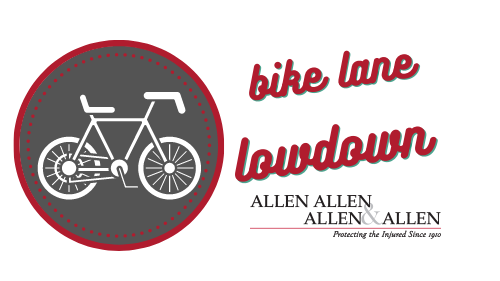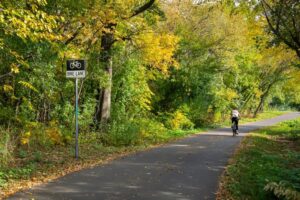For nearly two years, the Bike Lane Lowdown has covered the sweeping changes made to city planning due to the resurgence of bicycling. Plenty of bike lanes have been added to Central Virginia’s roads, but perhaps no project is as exciting as the Fall Line Trail. This highly-anticipated feature is a regional multi-use trail (including bike lanes and space for pedestrians) that will run along the fall line in Virginia.

What is Virginia’s fall line?
The fall line is a geological feature formed over 200 million years ago. It runs the length of our state, where the Piedmont portion collides with the coastal planes to the east. Hard bedrock gives way to soft sediment. Geologically, the area is marked by rapids and waterfalls, since the rivers drop 50-100 feet in elevation. In fact, half of the elevation loss is concentrated in a half-mile region in downtown Richmond, where the urban rapids are popular with whitewater enthusiasts. These dramatic features will ensure that the views along the Fall Line Trail will not disappoint!
What towns will the Fall Line Trail run through?
This trail will extend from Ashland to Petersburg, Virginia. The 43-mile trail will help to connect active transportation networks in the greater Richmond area. In fact, there will be a direct connection from the Fall Line Trail to Virginia’s popular Capital Trail, which runs from Richmond to Jamestown, Virginia.
Several components of the Fall Line Trail already exist or have been planned within special areas.
These areas include:
- The Ashland Trolley Line
- Chester Linear Park
- Trolley Line Connector
- Brook Road’s protected bike lanes
- Northern Jefferson Davis Special Area Plan
The Fall Line Trail will run through the following major areas:
- Ashland
- Hanover
- Henrico
- Richmond
- Chesterfield
- Colonial Heights
- Petersburg
Additional key points along the trail include:
- 24 public schools
- Randolph Macon College
- Virginia Union University
- VCU
- Virginia State University
- John Tyler Community College
- J. Sargeant Reynolds Community College
- Transit connections in Richmond and Chesterfield
- Multiple major parks

What benefits does the Fall Line Trail bring?
The Fall Line Trail will bring health, safety, and economic benefits to its surrounding communities. Having a dedicated infrastructure for biking and walking provides a tremendous safety benefit to pedestrians and bicyclists, reducing collisions with motor vehicles. Additionally, the trail provides increased opportunities for people to get outside, be active, and stay healthy. Multi-use bike trails also boast economic benefits, encouraging tourism and job creation.
When will construction begin?
In addition to the built-in portions of the trail that already exist, Henrico County has officially broken ground on its portion of the Fall Line Trail. The former Bank of America on Lakeside Avenue has been purchased by Henrico County, and will be designated as a welcome center. This site is rich in history, as it is also the location of Spring Park. Built in the 1800s, the sulfur springs were built out and encased in granite, and locals used them for healing soaks until 1933. This area is also conveniently located across the street from Bryan Park, which will host a portion of the trail.
In all, the project will cost a total of $266.5 million. Continued evaluations and engineering assessments will be made prior to each construction project.
Multi-use trails are important safety features, but not everyone has access to them on a local level. If you or a loved one have been injured in a bike or pedestrian accident through no fault of your own, you may be entitled to compensation. Call Allen & Allen for a free consultation, at 866-388-1307.


